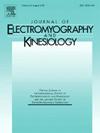Diagnostic accuracy of Tensiomyography parameters for monitoring peripheral neuromuscular fatigue
Abstract
The diagnostic accuracy of tensiomyography (TMG) parameters compared to the gold standard in neuromuscular fatigue evaluation using voluntary and electrically induced muscle activation is unclear. This study aimed to investigate the diagnostic accuracy of TMG parameters to detect individual changes after interventions that were designed to induce central or peripheral fatigue. Nineteen males (age: 32.2 ± 9.3 years) performed two interventions, consisting of maintaining 25% of maximal voluntary contraction (MViC25%) and a 30 s all-out cycling test (Wingate), respectively. TMG parameters, maximum voluntary contraction (PtMViC), voluntary activation (VA%) and electrically elicited double twitches (Dtw) were assessed on the knee extensors before (PRE), one minute (POST) and seven minutes after (POST7) the intervention. The diagnostic accuracy (AUC) of TMG parameters were evaluated in comparison to two criteria measures (PtMViC and Dtw). RM ANOVA revealed a significant interaction between the effects of intervention and time on VA% (p = 0.001) and Dtw (p < 0.001) but not for PtMViC (p = 0.420). AUC showed that TMG parameters had a good ability in detecting muscular fatigue assessed by Dtw but not by PtMViC. The results of the current study suggest that TMG parameters can be used to monitor peripheral neuromuscular fatigue.

 求助内容:
求助内容: 应助结果提醒方式:
应助结果提醒方式:


